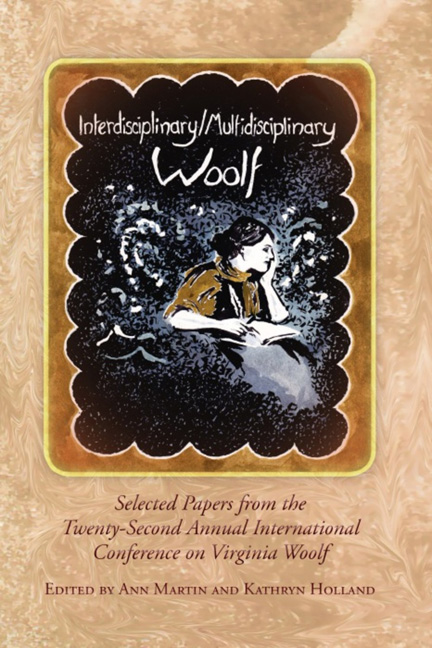Book contents
- Frontmatter
- Contents
- Introduction to Interdisciplinary/Multidisciplinary Woolf
- Acknowledgments
- List of Abbreviations
- History, Materiality, Multiplicity
- Patterns, Practices, Principles
- Art, Influence, Embodiment
- “Time has whizzed back an inch or two on its reel”: Relating Virginia Woolf and Emily Carr through Vintage Postcards, Lily Broscoe, Mrs. McNab, and the Cinematic Time of To the Lighthouse
- Speaking Citizen to Citizen in a Time of War: Miss La Trobe's Use of Parabasis in her Historical Pageant
- Work as Salvation: Eureka's Angel in the House, A Dircetor's Experience
- Drawing as Thinking: A Visual Response to To the Lighthouse
- Performing Feminism, Transmitting Affect: Isadora Duncan, Virginia Woolf, and the Politics of Movement
- Virginia Woolf and Clarice Lispector: Thinking Back Through Brazilian Mothers
- Mystical Gibberish or Renegade Discourse?: Poetic Language According to Orlando
- Selves and Others as Narrative Participants in Woolf's Novels
- Publishing, Politics, Publics
- Notes on Contributors
- Conference Program
Speaking Citizen to Citizen in a Time of War: Miss La Trobe's Use of Parabasis in her Historical Pageant
from Art, Influence, Embodiment
- Frontmatter
- Contents
- Introduction to Interdisciplinary/Multidisciplinary Woolf
- Acknowledgments
- List of Abbreviations
- History, Materiality, Multiplicity
- Patterns, Practices, Principles
- Art, Influence, Embodiment
- “Time has whizzed back an inch or two on its reel”: Relating Virginia Woolf and Emily Carr through Vintage Postcards, Lily Broscoe, Mrs. McNab, and the Cinematic Time of To the Lighthouse
- Speaking Citizen to Citizen in a Time of War: Miss La Trobe's Use of Parabasis in her Historical Pageant
- Work as Salvation: Eureka's Angel in the House, A Dircetor's Experience
- Drawing as Thinking: A Visual Response to To the Lighthouse
- Performing Feminism, Transmitting Affect: Isadora Duncan, Virginia Woolf, and the Politics of Movement
- Virginia Woolf and Clarice Lispector: Thinking Back Through Brazilian Mothers
- Mystical Gibberish or Renegade Discourse?: Poetic Language According to Orlando
- Selves and Others as Narrative Participants in Woolf's Novels
- Publishing, Politics, Publics
- Notes on Contributors
- Conference Program
Summary
Between the Acts, I would like to argue, is formally one of Woolf's most forward thinking texts; the novel as a whole and La Trobe's play in particular constitute Woolf's manifesto for the role the autonomous work of art plays in dreadful times. It seems ironic, then, that I need to go back in history to highlight this novel's innovations, first to the infamous year 1910, and then even further to the Greeks. Woolf's essay “Character in Fiction” marked 1910 as a year of profound change; many Woolf scholars agree that the choice of date is at least partly a reference to Roger Fry's exhibition “Manet and the Post-Impressionists” at the Grafton Galleries. In turn, Fry's influential formalist aesthetics can be seen as the opening gesture toward a theory of autonomous art. Hans Georg Gadamer and Theodor Adorno, two of the century's most important theorists of the autonomy of art, also view 1910 as a significant moment. In “The Relevance of the Beautiful,” Gadamer describes the “Cubist break with tradition, which led to the total elimination of any reference to an external object of the process of artistic creation,” arguing that epistemological crises like those which attended modernity inevitably question the “truth” of art, and in turn, question the forms that truth has taken, producing formal revolutions like those we can see in Cezanne's paintings, Picasso's collages, or Woolf's novels. Adorno observes that while in 1910 “the place of art became uncertain” its “autonomy remains irrevocable” (Aesthetic Theory 1). Gadamer and Adorno came to see the autonomy of art as a species of paradoxically engaged disengagement. For Adorno “Art becomes social by its opposition to society, and it occupies this position only as autonomous art. By crystallizing in itself as something unique to itself, rather than complying with existing social norms and qualifying as ‘socially useful,’ it criticizes society by merely existing ” (225-6). The autonomous work of art achieves its autonomy by means of its form. As Denis Donoghue writes in Speaking of Beauty
Form is counter-statement…Society makes statements and sends forth instructions, edicts, laws, definitions of reality.
- Type
- Chapter
- Information
- Interdisciplinary/Multidisciplinary Woolf , pp. 164 - 170Publisher: Liverpool University PressPrint publication year: 2013



